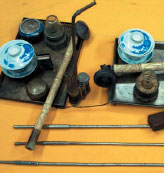For centuries, opium was to China what alcohol was to the West. The opium pipe was brought to China in the Qing Dynasty (1644-1911) and presented to dignitaries from noble families. The use and abuse of opium became much more prevalent from the 1830s, when the British began importing opium into the country in large quantities.

From then on, a large number of opium-related artifacts would be found in smoking stores, including opium pipe bowls, copper opium shipping tins and glass alcohol lamps. Smoking opium required a particular type of pipe called yen tsiang or "smoking pistol." Popular pipe stems were 16-20 inches in length and made of goat bone, with one end open and the other end sealed. A ceramic bowl (yen low) was inserted approximately 6 inches from the open end and attached to the pipe by a connecting flange and copper saddle.
Beijing collector Song Zhenzhong combed the city for fittings to match the parts of an opium pipe he had acquired. "It was found at an antique market in Beijing," he said, pointing to a jade section of the pipe he had bought a decade ago.
Other opium-related artifacts housed by Song include a mini-spoon used with opium ointment, small lamp for igniting the opium and ceramic teacup for gargling, as well as a copper container for carrying all the accessories.
Another item of his collection, a round pipe bowl made in low relief, showed a river scene with reeds. The characters on the panel to the right of the sampan are Xiang Xi, or Xiangxi River, an area in Hunan Province known for its lush, picturesque landscapes.
In addition to the pipe, a heat source was needed to ignite the opium. This was usually a small lamp fueled by vegetable oil. A needle on which to impale the opium for heating, and a small scraping tool or knife to dislodge the residue within the pipe and bowl was also used.
The most traditional Chinese smoking instrument is literally translated as, "water-smoking bag". It is a 30m long tobacco tube with a small water container at one end, and a short, lidded tobacco carrier standing beside it.
Story by Cheng Anqi and photo by Lu Zhongqiu
(China Daily 11/07/2007 page16)